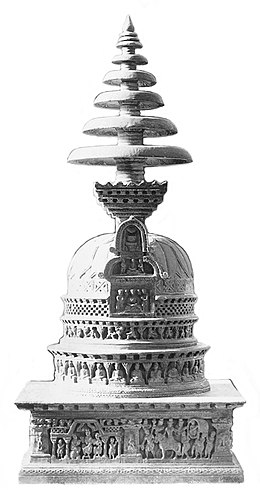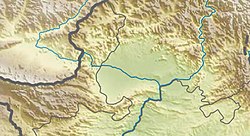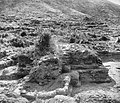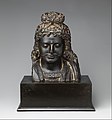
Kanishka I, or Kanishka the Great, an emperor of the Kushan dynasty in the second century, is famous for his military, political, and spiritual achievements. A descendant of Kujula Kadphises, founder of the Kushan empire, Kanishka came to rule an empire in Bactria extending to Pataliputra on the Gangetic plain. The main capital of his empire was located at Puruṣapura in Gandhara, with another major capital at Kapisa.

A stūpa is a mound-like or hemispherical structure containing relics that is used as a place of meditation. A related architectural term is a chaitya, which is a prayer hall or temple containing a stupa.

Greco-Buddhist art is the artistic manifestation of Greco-Buddhism, a cultural syncretism between the Classical Greek culture and Buddhism. Greco-Buddhist art is characterized by the strong idealistic realism and sensuous description of Hellenistic art and the first representations of the Buddha in human form, which have helped define the artistic canon for Buddhist art throughout the Asian continent up to the present. It is also a strong example of cultural syncretism between eastern and western traditions.

Vasudeva I was a Kushan emperor, last of the "Great Kushans." Named inscriptions dating from year 64 to 98 of Kanishka's era suggest his reign extended from at least 191 to 232 CE. He ruled in northern India, and still minted in coins in Balkh (Bactria) as well, although he probably had to deal with the rise of the Sasanians and the first incursions of the Kushano-Sasanians in the northwest of his territory.

The Kanishka casket or Kanishka reliquary, is a Buddhist reliquary made in gilded copper, and dated to the first year of the reign of the Kushan emperor Kanishka, in 127 CE. It is now in the Peshawar Museum in the historic city of Peshawar, Pakistan.
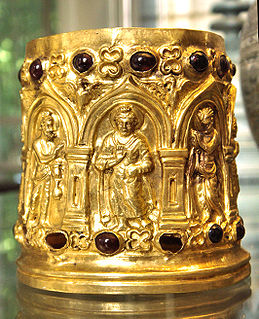
The Bimaran casket or Bimaran reliquary is a small gold reliquary for Buddhist relics that was found inside the stupa no.2 at Bimaran, near Jalalabad in eastern Afghanistan.

Bharhut is a village located in the Satna district of Madhya Pradesh, central India. It is known for its famous relics from a Buddhist stupa. The most famous donor for the Bharhut stupa was King Dhanabhuti.

Sodasa was an Indo-Scythian Northern Satrap and ruler of Mathura during the later part of the 1st century BCE or the early part of 1st century CE. He was the son of Rajuvula, the Great Satrap of the region from Taxila to Mathura. He is mentioned in the Mathura lion capital.
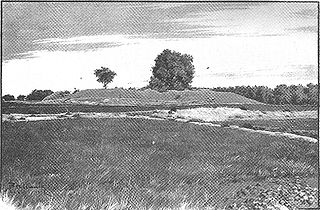
The Kanishka stupa was a monumental stupa established by the Kushan king Kanishka during the 2nd century CE in today's Shaji-ki-Dheri on the outskirts of Peshawar, Pakistan.
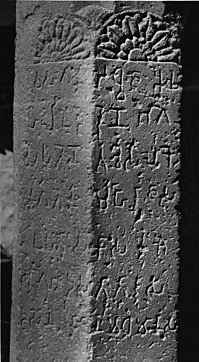
The Indo-Greeks practiced numerous religions during the time they ruled in present-day northwestern India from the 2nd century BCE to the beginning of the 1st century CE. In addition to the worship of the Classical pantheon of the Greek deities found on their coins, the Indo-Greeks were involved with local faiths, particularly with Buddhism, but also with Hinduism and Zoroastrianism.

Indo-Greek art is the art of the Indo-Greeks, who reigned from circa 200 BCE in areas of Bactria and the Indian subcontinent. Initially, between 200 and 145 BCE, they remained in control of Bactria while occupying areas of India, until Bactria was lost to invading nomads. After 145 BCE, Indo-Greek kings ruled exclusively in parts of ancient India, especially in Gandhara and the area of Punjab. The Indo-Greeks had a rich Hellenistic heritage and artistic proficiency as seen with the remains of the city of Ai-Khanoum, which was founded as a Greco-Bactrian city. In India, several Indo-Greeks cities are known such as Sirkap near Taxila, or Barikot, where some Indo-Greek artistic remains have been found, such as stone palettes. Some Buddhist cultural objects related to the Indo-Greeks are known, such as the Shinkot casket. But by far the most important Indo-Greek remains in India are the beautiful and numerous coins of the Indo-Greek kings, considered as some of the most artistically brilliant of Antiquity. Most of the works of art of the Greco-Buddhist art of Gandhara are usually attributed to the direct successors of the Indo-Greeks in India in the 1st century CE, such as the nomadic Indo-Scythians, the Indo-Parthians and, in an already decadent state, the Kushans. Many Gandharan works of art cannot be dated exactly, leaving the exact chronology open to interpretation. With the realization that the Indo-Greeks ruled in India until at least 10-20 CE with the reign of Strato II in the Punjab, the possibility of a direct connection between the Indo-Greeks and Greco-Buddhist art has been reaffirmed recently.

Bhamala Stupa is a ruined Buddhist stupa and National Heritage Site near Haripur, Pakistan that dates to the 2nd century CE. It is located on the bank of Haro River, a tributary of a Khanpur Dam, and is a tourist destination. Bhamala stupa is part of the larger Bhamala Buddhist Complex. The site is known for its 1,700 year old statue of the Buddha attaining enlightenment - considered the oldest such statue in the world.

Shaji-ki-Dheri is the site of an ancient Kanishka stupa about 6 kilometers from Peshawar, Pakistan.

The Yavana Era, Yona Era or Yonana Era was a computational era used in the Indian subcontinent from the 2nd century BCE for several centuries thereafter, probably starting in 174 BCE. It was initially thought that the era started around 186 BCE, and corresponded to accession to the Greco-Bactrian throne of Demetrius, who is said to have initiated the Indo-Greek conquest of parts of Northwestern South Asia. It is now equated with the formerly theorized "Old Śaka era".

The Art of Mathura refers to a particular school of Indian art, almost entirely surviving in the form of sculpture, starting in the 2nd century BCE, which centered on the city of Mathura, in central northern India, during a period in which Buddhism, Jainism together with Hinduism flourished in India. Mathura "was the first artistic center to produce devotional icons for all the three faiths", and the pre-eminent center of religious artistic expression in India at least until the Gupta period, and was influential throughout the sub-continent.

The Indasala Cave, also called Indrasila Guha or Indrasaila Cave, is a cave site mentioned in Buddhist texts. It is stated in Buddhist mythology to be the cave where Buddha lived for a while, and gave the sermon called the Sakkapañha Sutta to deity Indra. This Sutta is found as chapter II.21 of Digha Nikaya. In this sermon, the Buddha addresses Sakya accompanied by Pancasikha. After some harp-playing by Pancasikha, Indra asks 42 questions to the Buddha, which he answers. The teachings in this Indrasala Cave Sutta is, in part, the basis for the Theravada tradition of "punna and varam (favor).

Gandhāran Buddhism refers to the Buddhist culture of ancient Gandhāra which was a major center of Buddhism in the Indian subcontinent from the 3rd century BCE to approximately 1200 CE. Ancient Gandhāra corresponds to modern day north Pakistan, mainly the Peshawar valley and Potohar plateau as well as Afghanistan's Jalalabad. The region has yielded the Gandhāran Buddhist texts written in Gāndhārī Prakrit the oldest Buddhist manuscripts yet discovered. Gandhāra was also home to a unique Buddhist artistic and architectural culture which blended elements from Indian, Hellenistic, Roman and Parthian art. Buddhist Gandhāra was also influential as the gateway through which Buddhism spread to Central Asia and China.

Kushan art, the art of the Kushan Empire in northern India, flourished between the 1st and the 4th century CE. It blended the traditions of the Greco-Buddhist art of Gandhara, influenced by Hellenistic artistic canons, and the more Indian art of Mathura. Kushan art follows the Hellenistic art of the Greco-Bactrian Kingdom as well as Indo-Greek art which had been flourishing between the 3rd century BCE and 1st century CE in Bactria and northwestern India. Before invading northern and central India and establishing themselves as a full-fledged empire, the Kushans had migrated from northwestern China and occupied for more than a century these Central Asian Hellenistic lands, where they are thought to have assimilated remnants of Greek populations, Greek culture and Greek art, as well as the languages and scripts which they used in their coins and inscriptions: Greek and Bactrian, which they used together with the Indian Brahmi script.

The Kimbell seated Bodhisattva is a statue of the "Bodhisattva" from the Art of Mathura, now held by the Kimbell Art Museum. The statue is dated to 131 CE, thanks to an inscription mentioning its dedication in "Year 4 of the Great King Kanishka", since the date of the beginning of Kanishka's reign is thought to be 127 CE. The Kimbell seated Bodhisattva belongs to the category of the "Seated Buddha triads", which can be seen contemporaneously in the Greco-Buddhist art of Gandhara and in the art of Mathura in the early Kushan period.
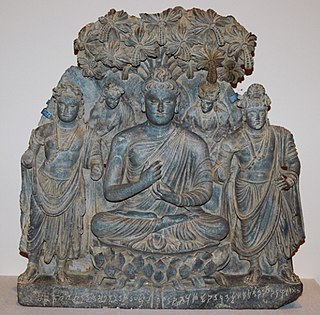
The Brussels Buddha is a famous Buddha statue of the Greco-Buddhist art of Gandhara. It is named after the first collection to which it belonged, the Marteau collection in Brussels, Belgium, although it is now in a private collection in Japan, belonging to the Agonshū sect of Buddhism. The Brussels Buddha belongs to the category of the "Seated Buddha triads", which can be seen contemporaneously in the Greco-Buddhist art of Gandhara and in the art of Mathura in the early Kushan period. The precise location where the statue was discovered is unknown, but it was acquired in Peshawar, and it is thought to have been excavated in Sahri Bahlol due to its similarity with a statue from the same location, now in the Peshawar Museum.
